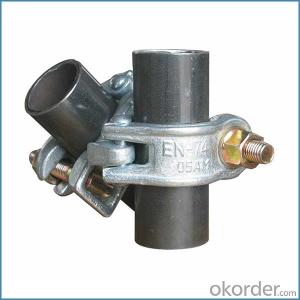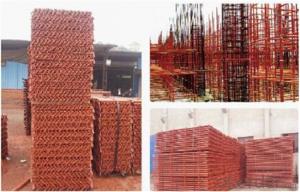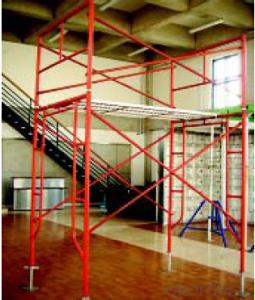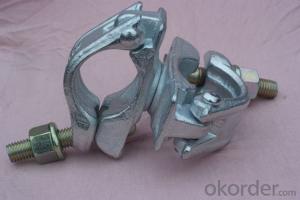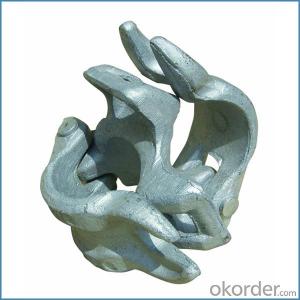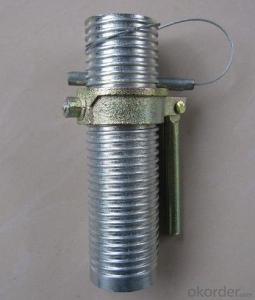Scaffolding Steel Coupler British Type for Sale
- Loading Port:
- Tianjin
- Payment Terms:
- TT OR LC
- Min Order Qty:
- 1000 kg
- Supply Capability:
- 100000 kg/month
OKorder Service Pledge
OKorder Financial Service
You Might Also Like
Scaffolding Steel Coupler British Type for Sale
Description
1.The scaffolding coupler is always used to connect the steel pipe as scaffolding system.
2.The often used coupler is swivel coupler and righ angle coupler .
3.We can provide types of scaffolding coupler according to your requirement.
4.Couoler can fix the 48.3mm scaffolding steel pipe tightly and make the whole scaffolding system more steadily.
5.Material:Q235 steel
6.Overall Size:48.3mm*48.3mm
7.Surface Finish: Galvanized/ Painted
8.Standard:BS1139,EN74
9.Package:25pcs/bag
10.Manufactuering as per customer requirements

Feature
(1)Excellent Anti-Breaking—Cold Pressed Steel
(2)Outstanding Resistance Deformation
(3)Strong Anti-Dropping Ability
(4)Longtime USe
(5)Qualtity Guaranteed
(6)OEM Service
Photo



Parameter
| Material | Q235,345steel |
| Size | 48.3mm*48.3mm |
| Surface finish | Galvanized |
| Weight | 1.1kg around |
| Standard | BS1139,EN74 |
| Package | 25pcs/bag,steel pallet |
| Manufacture | As per customer requirement |
| Market | Africa, South America, the Middle East and Asia |
FAQ
Q: Are you a factory or trading company?
We are a state-owned corporation in China,dealing with various kinds of building materials.We have our holding subsidiaries.
Q: Where is your factory located? How can I visit there?
Our factory is located all around China.
Q: Can I get some samples?
Sample is free, customer only pay freight for the first time.
Q: Delivery?
10-30days. (5-15 containers)
Any question,feel free to contact us.
- Q: 6 meters high outside the wall to be maintenance, scaffolding how to count
- 1 choose to charge the treasure, the most important thing is not to buy the virtual standard things; the beginning of the use of charge treasure people know that a lot of charging treasure are false, shouting can charge 10 times dozens of times, the results bought It is only 1-2 times, and the price is very cheap, so let everyone mistakenly believe that the price of charging treasure should be the price, dozens of dollars, when I bought about 100 mA of the charge when the treasure, Friends say I bought expensive, Shanghai for the high good 薨 spring for the sickle said they 20-30 dollars to buy a hundred thousand milliamperes, I asked to be washed several times, he said 2-3 times, I That I can charge the apple 5 times, a sub-price goods, do not covet small cheap
- Q: Are there any specific guidelines for the safe use of steel tube couplers in scaffolding near confined spaces or trenches?
- There exist specific guidelines for the safe utilization of steel tube couplers in scaffolding near confined spaces or trenches. First and foremost, it is imperative to guarantee that competent personnel with the necessary knowledge and experience design and erect the scaffolding. A competent individual must inspect and approve the scaffolding before it is put into use. When operating in close proximity to confined spaces or trenches, it is vital to evaluate the risks associated with the particular area. This evaluation should encompass factors such as ground stability, the presence of underground utilities, and the potential for collapse or engulfment. To mitigate these risks, additional precautions should be implemented. These precautions may involve providing extra bracing or supports to the scaffolding structure, utilizing guardrails and toe boards to prevent falls, and implementing a permit-to-work system to regulate access to the confined space or trench. Furthermore, it is crucial to ensure that all workers are adequately trained in the safe usage of steel tube couplers and scaffolding equipment. They should be well-acquainted with the manufacturer's instructions and guidelines for assembly, disassembly, and usage. Regular inspections and maintenance of the scaffolding and couplers should also be carried out to identify any defects or damages that could jeopardize safety. Any issues should be promptly addressed and rectified. Lastly, having an emergency plan in place is of utmost importance in the event of an incident or accident. This plan should encompass procedures for evacuating workers, providing first aid, and contacting emergency services. By adhering to these guidelines, the safe usage of steel tube couplers in scaffolding near confined spaces or trenches can be ensured, thereby minimizing risks to workers and maintaining a safe working environment.
- Q: i really wanna go get it tomorrow, can you guys tell me about it? i have a couple question. I know pain is different for everyone, but how bad does it hurt on average? how do they pierce it? i watched a video online and it looks like they shove one thing through to make one hole, another thing through to make another hole, then attach the bar to end of the thing and slide it through, and then do the same thing to the other one. is that how it works? what happens if your ears grow? hahah i know thats an odd question, but hey its a concern haha i think thats all i wanted to know, if you could help out and answer that would be great!!
- My scaffold, also known as an industrial, was one of my more painful, but it's not unbearable. It hurts mostly because it's two piercings done at once, which sort of just sets the upper part of your ear on fire at first, but it dulls down and is just sore after a while. Heal time is about 6 months, and you're sore for maybe the first month. They pierce it with a hollow needle one hole at a time, starting with the cartilage (or at least that's how mine was done.) And just follow through from there to the lower piercing. They slide the bar through using the hollow needle and attach the ends, etc. Ears, in your teens, generally aren't gonna get any bigger, so you'll be fine. And swelling in minimal - cartilage doesn't swell. Just take good care of both holes and keep your jewelry in. Your piercer will be able to answer everything beforehand - that's what he/she is there for. Just ask to make sure, never be afraid to ask.
- Q: so i got my scaffolding pierced 10 days ago, yesterday i went to the piercer and they said i was able to change from two seperate smaller bars to the long barbell. which is what i did last night, but now it is really painful but only on the bottom piercing, the top one is only painful to touch whereas the bottom one has a throbbing pain and is really swollen and red. ive been cleaning it but is this normal? im not taking it out or changing it as that will irritate it more and i don't want that so. any ideas? thanks
- You're not supposed to change jewelry until the piercing has healed. It can irritate and infect the piercing. I'd say it's just irritated right now. But I'd keep a close eye on it. If there's any puss, go to a doctor. Not back to your piercer. Your piercer should know that you can't change jewelry until it's healed, and they might've really screwed up your piercing. So if there's puss, definitely see a doctor. But right now just take some anti-inflammatories and do sea salt soaks and antibacterial soap washes. You can also buy tea tree oil and add a few drops to the sea salt soak. Tea tree oil is great with helping the healing process, and it can be found at any drug store or walmart! Just clean it, and keep a close eye on it. Industrials need to be babyed during the healing process since they're one of the most difficult healers. Good luck!
- Q: i have a dance show coming up in march and i need to wear a clear retainer or barbell in replacement for my normal scaffold barbell. it's 1.6mm x 38mmi cant seem to find one anywhere :( i like in the UK and march isn't that far away so i'm starting to stress about this PLEASEEE HELP i will be very grateful!Many Thanks
- how long have you had your scaffold piercing? if it is still healing you will want to avoid acrylic (plastic) jewelry. go by a piercing shop and tell them that you want to get a PTFE (tygon) bar. Alternately, you can get two separate pieces of jewelry (as long as they are the same mm as what you currently have) and wear them. if you can shop online, you may have luck with checking out american sites. 1.6mm=14 gauge.
- Q: Are steel tube couplers resistant to chemical exposure?
- Due to its inherent properties, stainless steel is generally resistant to chemical exposure, making steel tube couplers a suitable choice for applications involving contact with chemicals. However, the level of resistance may vary depending on the specific type of steel, as well as the concentration and type of chemical involved. In certain instances, steel tube couplers can still be susceptible to damage or corrosion, particularly when exposed to high concentrations or prolonged periods of exposure. Therefore, it is crucial to carefully consider the chemical environment and seek guidance from experts or manufacturers to ensure the appropriate selection of steel and implementation of protective measures. This is vital for maintaining the durability and reliability of the couplers in environments where they are exposed to chemicals.
- Q: Are there any limitations to the use of steel tube couplers in scaffolding?
- Yes, there are limitations to the use of steel tube couplers in scaffolding. One limitation is that they may not be suitable for certain types of scaffolding structures that require specialized connectors. Additionally, steel tube couplers have weight limitations and may not be able to support heavy loads. It is also important to consider the compatibility of different coupler types and sizes, as mismatched couplers can compromise the stability and safety of the scaffold.
- Q: Are steel tube couplers compatible with different sizes and types of scaffolding tubes?
- Steel tube couplers can be used with various sizes and types of scaffolding tubes, allowing for a secure and reliable connection. These couplers are specifically designed to create a strong and stable structure by joining scaffolding tubes of different sizes and types. They come in different sizes and configurations to cater to the specific requirements of different scaffolding systems. Whether it involves connecting steel tubes of different diameters or combining steel and aluminum tubes, steel tube couplers offer a versatile and dependable solution. However, to guarantee the safety and durability of the scaffolding system, it is crucial to follow the manufacturer's instructions and adhere to industry standards when using and securing the couplers.
- Q: Can steel tube couplers be used in scaffolding systems that need to support heavy loads or equipment for extended periods?
- Yes, steel tube couplers can be used in scaffolding systems that need to support heavy loads or equipment for extended periods. Steel tube couplers are known for their strong and durable nature, making them suitable for supporting heavy loads. They provide a secure and reliable connection between scaffold tubes, ensuring stability and safety. Additionally, steel tube couplers have a high load-bearing capacity and can withstand prolonged usage without compromising their structural integrity.
- Q: Are steel tube couplers compatible with different pipe sizes?
- No, steel tube couplers are not compatible with different pipe sizes. Steel tube couplers are specifically designed to connect tubes or pipes of the same size and dimensions. They provide a strong and secure connection between two tubes, ensuring structural stability and integrity. Attempting to use a steel tube coupler with pipes of different sizes will result in an improper fit, potentially leading to leaks, weak connections, or even structural failure. It is important to use the correct size of steel tube coupler that matches the size and dimensions of the pipes you are connecting.
Send your message to us
Scaffolding Steel Coupler British Type for Sale
- Loading Port:
- Tianjin
- Payment Terms:
- TT OR LC
- Min Order Qty:
- 1000 kg
- Supply Capability:
- 100000 kg/month
OKorder Service Pledge
OKorder Financial Service
Similar products
Hot products
Hot Searches
Related keywords
